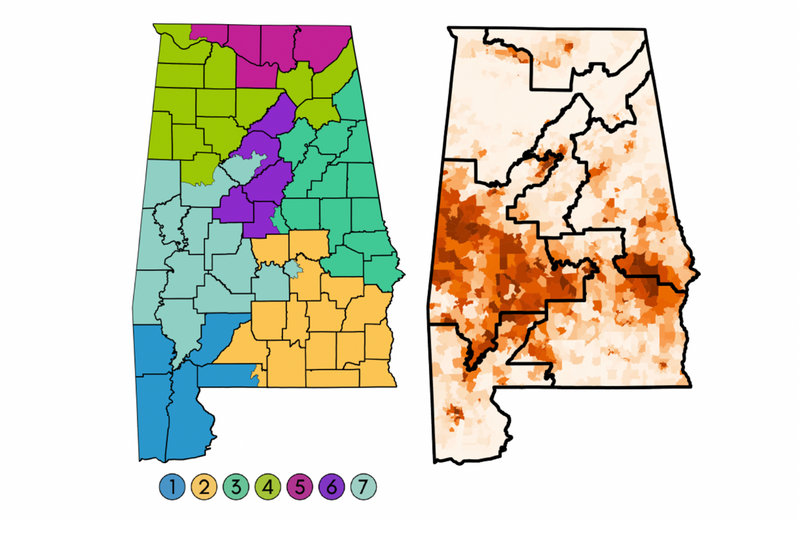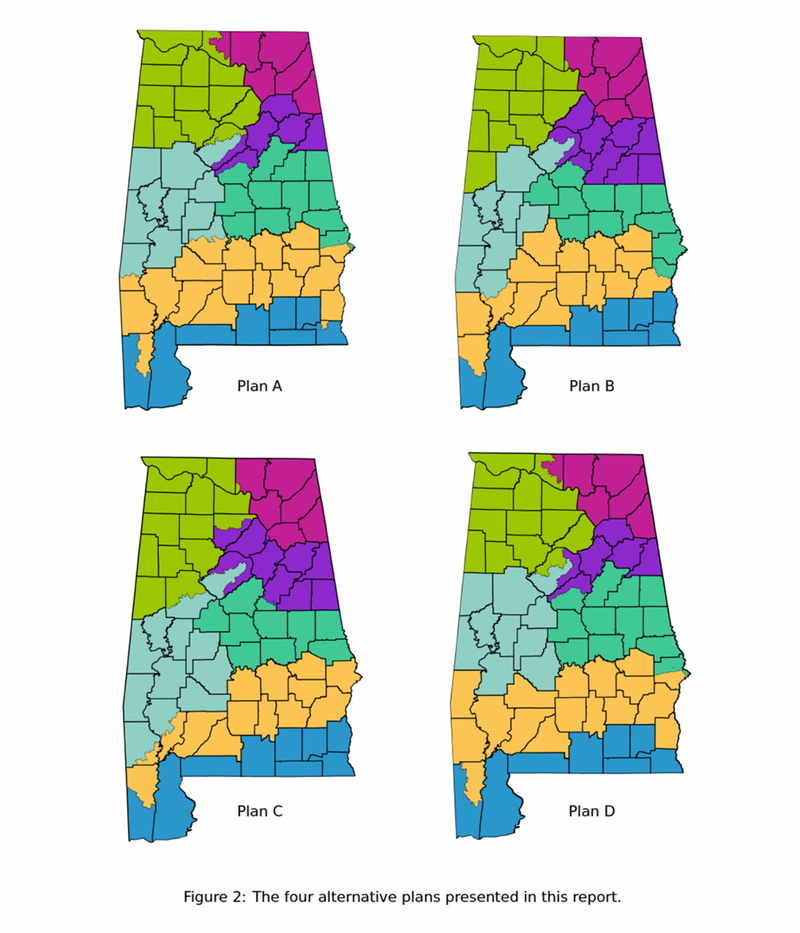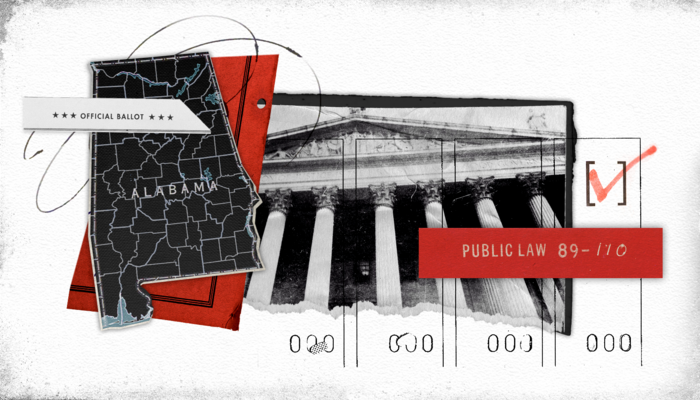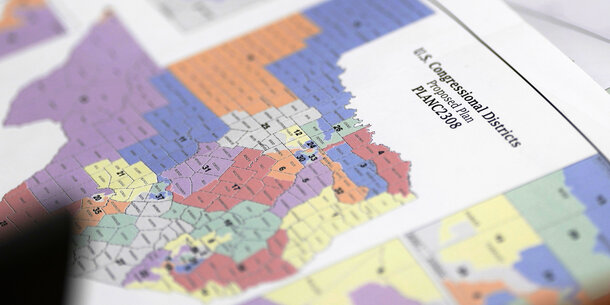On October 4, the Supreme Court will hear an Alabama redistricting case, Merrill v. Milligan, that could sharply limit the ability of communities of color to use the Voting Rights Act to fight discriminatory electoral maps.
For four decades, minority voters have been able to challenge discriminatory maps under Section 2 of the Voting Rights Act using a legal framework first laid out by the Supreme Court in 1986. The result has been increased representation of minority communities at every level of government.
But Alabama has asked the Supreme Court to radically rewrite the rules for Section 2 claims. A decision from the Supreme Court agreeing to Alabama’s far-reaching relief could make it harder for minority voters to challenge maps that dilute their political strength and deprive long disadvantaged minority communities of strong advocates on critical public investments and issues like healthcare, education, and criminal justice.
What is at issue in the Alabama case?
Federal lawsuits filed by Black voters contend that the state violated the Voting Rights Act because its new congressional map failed to create a second Black majority or plurality district in the state’s “Black Belt,” an 18-county, mostly rural region characterized by stark socioeconomic disparities and some of the nation’s highest rates of poverty.
Instead, Alabama lawmakers drew a map that continues a policy of dividing the Black Belt among four congressional districts, ignoring the request of Black constituents to be kept together in two districts for better representation as well as significant demographic changes in the region over the last couple of decades.
Because of the division of the Black Belt, the region’s Black voters have an ability to elect their preferred candidates only in the 7th District, a sprawling district with a tenacle stretching to Birmingham that the plaintiffs say is packed with far more Black voters than needed to elect a Black-preferred candidate.
 Source: Declaration of Moon Duchin filed by plaintiffs in Milligan v. Merrill.
Source: Declaration of Moon Duchin filed by plaintiffs in Milligan v. Merrill.
Meanwhile, in the 1st, 2nd, and 3rd Districts, the Black share of the population in each district is held to 30 percent or less thanks to surgical line-drawing choices like placing Montgomery and next-door Tuskegee (both heavily Black cities) in separate districts.
The small Black population of these three districts, combined with exceedingly high racially polarized voting, mean white voters will always be able to use their numerical superiority to block attempts by Black voters and their preferred candidates to put together a politically effective coalition.
Indeed, all three districts have consistently elected white representatives whose votes and priorities in the House are not well aligned with the needs and interests of the region’s Black voters. For example, the white representatives representing the 1st, 2nd, and 3rd Districts all recently voted against legislation that would have capped the cost of insulin at $35 a month, despite the fact that the region has a high rate of diabetes and a high number of people without health insurance.
What is the legal basis for the lawsuits?
The lawsuits seek relief under Section 2 of the Voting Rights Act, which requires that states’ electoral processes provide minority voters with an equal opportunity “to participate in the political process and to elect representatives of their choice.”
In redistricting cases, application of Section 2 takes place using a highly fact-intensive, multi-part test first laid out by the Supreme Court in 1986 in Thornburg v. Gingles.
To prevail under this well-established test, the plaintiffs in a case must show that the interaction between a state’s decisions about where to draw district boundaries and high levels of racially polarized voting and other adverse conditions on the ground combine to ensure that minority voters are perpetually shut out of power. Plaintiffs must also demonstrate that there are reasonable alternative configurations of districts that map drawers ignored or purposely avoided that would produce different outcomes for voters of color.
What did the trial court rule?
In January, a panel of three federal judges, including two Trump appointees, unanimously ruled that the state’s congressional map violated Section 2 of the Voting Rights Act of 1965 and ordered lawmakers to redraw it in time for the 2022 midterms to include a second Black majority or plurality district in the Black Belt.
The court’s opinion found that the evidence of racially polarized voting in the Black Belt was stark — on average, only around 15 percent of white voters in the region are willing to support the same candidates as the Black community. This low level of crossover support from white voters means that in the three Black Belt districts where the Black population is 30 percent or less, white voters are guaranteed to control who wins elections for the entire 10-year lifespan of the map, no matter how politically cohesive Black voters are or how hard they work to put together a winning cross-racial coalition.
The opinion also found there was “substantial and undeniable” evidence of lingering socioeconomic disparities in the region that “hinder Black Alabamians’ opportunity to participate in the political process,” including poverty levels rarely seen in developed countries.
Critically, the court also found that all of the disadvantages Alabama imposes on Black voters could have been easily avoided. The opinion noted that the plaintiffs’ experts had presented multiple non-discriminatory maps with districts, like the ones below, that are “at least as geographically compact as those in the [state’s] Plan, respect traditional boundaries at least as much as the Plan, protect important communities of interest, [and] protect incumbents where possible.”
 Source: Declaration of Moon Duchin filed by plaintiffs in Milligan v. Merrill.
Source: Declaration of Moon Duchin filed by plaintiffs in Milligan v. Merrill.
However, before the map could be redrawn, Alabama filed an emergency request for a stay at the Supreme Court, which was granted.
What is Alabama saying the trial court got wrong?
Alabama makes two main arguments in its effort to overturn the lower court’s judgment, both of which would significantly restrict the reach of the Voting Rights Act.
The state’s principal argument is that Section 2 imposes no liability because it is impossible to draw a second Black opportunity district on a “race blind” basis. According to Alabama, since the plaintiffs’ experts had to consider race and deviate slightly from the state “race neutral” districting rules in order to create demonstration plans with a second Black majority district, race “predominated” in the design of the maps, making them unconstitutional racial gerrymanders.
This is a radical argument that rewrites not only Section 2 precedent but also the Supreme Court’s racial gerrymandering jurisprudence to effectively prohibit any consideration of race in map drawing.
Under current Supreme Court precedent, race is one factor among many that map drawers may take into account. The only prohibition in the Supreme Court’s racial gerrymandering line of cases is that race cannot predominate over non-racial considerations in a way that results in racial essentializing, for example, by joining far-flung minority voters on opposite sides of a state who have nothing in common besides their race. But while map drawers cannot adopt arbitrary racial quotas or put voters in a district solely because of their race, there is no ban on keeping a politically cohesive racial or ethnic community together if there are also good non-racial reasons for doing so.
That mix of racial and non-racial justifications for a second Black Belt district is exactly what the trial court found in Alabama, describing the Black Belt as a well-defined and universally accepted community of interest of “substantial significance” with a long “shared history and common economy” dating back to the region’s days as the heart of Alabama’s 19th century cotton economy. While the population of the Black Belt is overwhelmingly Black, the court also found that region had multiple commonalities across “many, many more dimensions than skin color.” As the court pointed out, Alabama itself has a policy of keeping the Black Belt intact in its state board of education map.
 @2021 Caliper
@2021 Caliper
Accepting Alabama’s argument that state districting rules must be strictly followed would resolve any conflicts between state and federal law in favor of state policy preferences, essentially rendering the Constitution’s Supremacy Clause meaningless. Worse, it would be an open invitation to state and local governments to design “race neutral” criteria that deliberately frustrate the fair representation for minority communities protected by the Voting Rights Act. A state, for example, could adopt hard and fast rules that districts must be maximally compact or avoiding ever pairing incumbents, having the effect of making it impossible to create a minority opportunity district.
Alabama’s second major argument is an even more sweeping invitation for the court to rule that Section 2 does not apply to the drawing of single-member districts but only to multimember districts and challenges of at-large election systems. Under this argument, Section 2 could be used to strike down discriminatory use of at-large elections or multimember districts, but would offer no safeguards against similar discrimination in the resulting single-member district scheme. This is an extreme misreading of the Voting Rights Act that would require the Supreme Court to ignore the legislative history of Section 2 and overrule longstanding precedent allowing Section 2 challenges to redistricting plans.
One far-reaching argument, however, that Alabama is not advancing on appeal is its argument at the trial-court level that Section 2 claims can only be brought by the U.S. Department of Justice and not by individual voters. Although it raised the issue below, it did not include the argument in its briefing before the Supreme Court, and most observers think the high court is unlikely to take up the question of a private right of action on its own.
What would be the impact if the Supreme Court agrees with Alabama?
Even a modest reworking of the Section 2 framework could have significant ramifications for the ability of minority voters to use the Voting Rights Act to fight discriminatory redistricting. Depending on how the court decides, Section 2 could become harder to use or even completely inapplicable in redistricting cases.
The most immediate impact would be on cases in Georgia and Louisiana, where courts have already found that Section 2 requires redrawing of congressional maps to create additional Black districts. Cases in Texas, North Dakota, Washington, and other states where voters have filed lawsuits seeking the creation of additional minority opportunity districts for legislative or congressional offices would also be adversely impacted.
But the consequences are likely to be even graver at the local level, where Section 2 has been a powerful tool to ensure that bodies such as school boards, city councils, and county commissions are fair. In fact, since the Supreme Court laid out the Gingles test nearly four decades ago, Section 2 has played a far more transformative role in ensuring that voters of color have equal opportunities to participate in the political process and elect their candidates of choice at the local level than it has at the congressional or legislative levels. Just this past decade, for example, Section 2 litigation opened the door for the first time to Black representation on the city council and school board in sharply racially divided Ferguson, Missouri.
The ripple effects also could be significant. By ensuring that minority communities are not shut out of the political process, Section 2 plays an important role in guaranteeing that minority communities receive their fair share of public resources. Indeed, research on the transformative power of the Voting Rights Act shows that in jurisdictions where minority voters have successfully challenged discriminatory electoral districts, gaps in economic opportunity have narrowed and that investment in basic infrastructure like roads and schools has improved.
The Voting Rights Act has helped transform American democracy, helping minority voters pry open doors that had long been sealed shut. If the Supreme Court goes where Alabama wants it to, the onus will be on Congress and the states to find new ways to protect the country’s emerging multiracial democracy.




